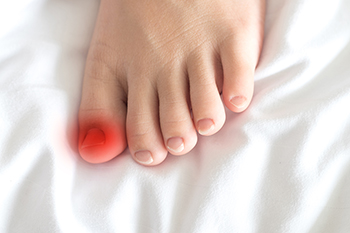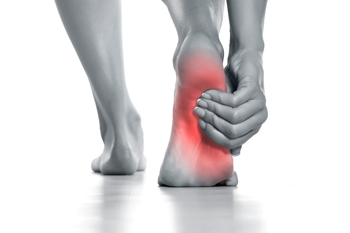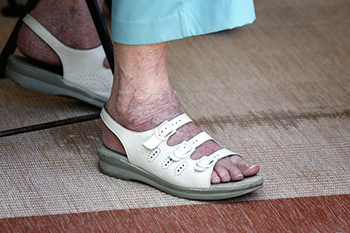Connect With Us
Blog
Items filtered by date: May 2025
Plantar Fasciitis and Common Risk Factors

Plantar fasciitis is the inflammation of the plantar fascia, a thick band of tissue that connects the heel bone to the toes and supports the arch of the foot. This condition is a common source of heel pain, especially during the first steps in the morning or after long periods of rest. Symptoms may include sharp or aching pain in the heel or arch of the foot, often worsening with activity. Risk factors for developing plantar fasciitis include prolonged standing, high-impact activities, obesity, and wearing unsupportive footwear. Individuals with flat feet or high arches may also be more prone to this condition. If you have heel pain, it is suggested that you contact a podiatrist sooner rather than later who can accurately diagnose and treat plantar fasciitis.
Plantar fasciitis is a common foot condition that is often caused by a strain injury. If you are experiencing heel pain or symptoms of plantar fasciitis, contact Charles Oehrlein, DPM from Hoover Foot Care. Our practitioner can provide the care you need to keep you pain-free and on your feet.
What Is Plantar Fasciitis?
Plantar fasciitis is one of the most common causes of heel pain. The plantar fascia is a ligament that connects your heel to the front of your foot. When this ligament becomes inflamed, plantar fasciitis is the result. If you have plantar fasciitis you will have a stabbing pain that usually occurs with your first steps in the morning. As the day progresses and you walk around more, this pain will start to disappear, but it will return after long periods of standing or sitting.
What Causes Plantar Fasciitis?
- Excessive running
- Having high arches in your feet
- Other foot issues such as flat feet
- Pregnancy (due to the sudden weight gain)
- Being on your feet very often
There are some risk factors that may make you more likely to develop plantar fasciitis compared to others. The condition most commonly affects adults between the ages of 40 and 60. It also tends to affect people who are obese because the extra pounds result in extra stress being placed on the plantar fascia.
Prevention
- Take good care of your feet – Wear shoes that have good arch support and heel cushioning.
- Maintain a healthy weight
- If you are a runner, alternate running with other sports that won’t cause heel pain
There are a variety of treatment options available for plantar fasciitis along with the pain that accompanies it. Additionally, physical therapy is a very important component in the treatment process. It is important that you meet with your podiatrist to determine which treatment option is best for you.
If you have any questions, please feel free to contact our office located in Hoover, Oneonta, and Munford, AL . We offer the newest diagnostic and treatment technologies for all your foot care needs.
What Is a Curled Toenail?

Curled toenails, also known as involuted or pincer nails, occur when the sides of the nail begin to curve inward, sometimes digging into the surrounding skin. This condition can be caused by genetics, wearing improper footwear that puts pressure on the toes, or fungal infections that can gradually distort nail shape. Other causes may include trauma or long-term neglect of proper nail care. Symptoms can range from mild discomfort to sharp pain, especially when walking or wearing tight shoes. The skin around the nail may become red, tender, or swollen, and, in some cases, an infection may develop. A podiatrist can assess the severity and underlying cause of the curled toenail. Treatment options include trimming and reshaping the nail, treating fungal infections, recommending proper footwear, or using special devices to gradually correct the nail’s shape. In more severe cases, partial nail removal or minor procedures may be necessary. If you are experiencing this condition, it is suggested that you schedule an appointment with a podiatrist for appropriate treatment.
Ingrown toenails may initially present themselves as a minor discomfort, but they may progress into an infection in the skin without proper treatment. For more information about ingrown toenails, contact Charles Oehrlein, DPM of Hoover Foot Care. Our practitioner can provide the care you need to keep you pain-free and on your feet.
Ingrown Toenails
Ingrown toenails are caused when the corner or side of a toenail grows into the soft flesh surrounding it. They often result in redness, swelling, pain, and in some cases, infection. This condition typically affects the big toe and may recur if it is not treated properly.
Causes
- Improper toenail trimming
- Genetics
- Improper shoe fitting
- Injury from pedicures or nail picking
- Abnormal gait
- Poor hygiene
You are more likely to develop an ingrown toenail if you are obese, have diabetes, arthritis, or have any fungal infection in your nails. Additionally, people who have foot or toe deformities are at a higher risk of developing an ingrown toenail.
Symptoms
Some symptoms of ingrown toenails are redness, swelling, and pain. In rare cases, there may be a yellowish drainage coming from the nail.
Treatment
Ignoring an ingrown toenail can have serious complications. Infections of the nail border can progress to a deeper soft-tissue infection, which can then turn into a bone infection. You should always speak with your podiatrist if you suspect you have an ingrown toenail, especially if you have diabetes or poor circulation.
If you have any questions, please feel free to contact our office located in Hoover, Oneonta, and Munford, AL . We offer the newest diagnostic and treatment technologies for all your foot care needs.
Three Common Foot Disorders

Bunions, plantar fasciitis, and Morton’s neuroma are common foot disorders that cause pain and difficulty walking. A bunion occurs when the big toe deviates from the smaller toes, creating a bony bump at the base of the joint. A podiatrist can recommend modifying footwear, using orthotic devices, or, in persistent cases, performing surgery to correct the deformity. Plantar fasciitis, a painful inflammation of the connective tissue along the bottom of the foot, often causes heel pain, especially after periods of rest. Treatment includes stretching, wearing supportive footwear, orthotic inserts, or surgery, if symptoms remain after more conservative care. Morton’s neuroma involves thickening of nerve tissue between the toes, often leading to burning pain or numbness in the ball of the foot. A podiatrist may suggest shoe modifications, metatarsal pads, or carefully considered injections. If necessary, surgery may be needed to remove the affected nerve. If you regularly experience foot pain, it is suggested that you schedule an appointment with a podiatrist for a diagnosis and appropriate treatment.
Foot Pain
Foot pain can be extremely painful and debilitating. If you have a foot pain, consult with Charles Oehrlein, DPM from Hoover Foot Care. Our practitioner will assess your condition and provide you with quality foot and ankle treatment.
Causes
Foot pain is a very broad condition that could be caused by one or more ailments. The most common include:
- Bunions
- Hammertoes
- Plantar Fasciitis
- Bone Spurs
- Corns
- Tarsal Tunnel Syndrome
- Ingrown Toenails
- Arthritis (such as Gout, Rheumatoid, and Osteoarthritis)
- Flat Feet
- Injury (from stress fractures, broken toe, foot, ankle, Achilles tendon ruptures, and sprains)
- And more
Diagnosis
To figure out the cause of foot pain, podiatrists utilize several different methods. This can range from simple visual inspections and sensation tests to X-rays and MRI scans. Prior medical history, family medical history, and any recent physical traumatic events will all be taken into consideration for a proper diagnosis.
Treatment
Treatment depends upon the cause of the foot pain. Whether it is resting, staying off the foot, or having surgery; podiatrists have a number of treatment options available for foot pain.
If you have any questions, please feel free to contact our office located in Hoover, Oneonta, and Munford, AL . We offer the newest diagnostic and treatment technologies for all your foot care needs.
Why Live with Pain and Numbness in Your Feet?
Common Causes of Foot Pain Among Elderly People

Foot pain is a frequent complaint among elderly individuals and can significantly affect mobility and independence. One common cause is hallux valgus, a deformity of the big toe joint that often leads to bunions, swelling, and discomfort when walking. Abnormal structure of the medial arch can also contribute to pain, especially if the arch is excessively high or collapsed, placing extra strain on other parts of the foot. Neurological disorders, such as peripheral neuropathy or spinal issues, can lead to altered sensation, burning pain, or muscle weakness in the feet. These conditions often interfere with balance and walking. If you are a senior or caring for an older person and have foot pain, it is suggested that you visit a podiatrist who can treat various foot conditions.
If you need your feet checked, contact Charles Oehrlein, DPM of Hoover Foot Care. Our practitioner will attend to all of your foot and ankle needs and provide you with quality treatment.
Geriatrics and Podiatry
When people age, some common issues that may occur are bone density loss, dry skin, poor circulation, and rough brittle nails. These issues may also affect your foot health if the necessary steps are not taken to alleviate the problems.
It is important to take care of your feet because feet that are injured or diseased can affect your overall health. Having painful feet hinders your ability to do daily activities or may decrease your willingness to do the things that you need to do.
Visiting Your Geriatrician
As we age, health problems become more likely, so it is essential to visit your doctor for check-ups to ensure that you are doing the best you can to take care of your health. It is recommended to check your feet frequently for any possible cuts, bruises, swelling, corns or any other irregularities.
Taking Care of Elderly Feet
Cracked or dry feet can be treated by applying moisturizer often. It is also important not to wear old socks because the older the sock is, the higher the possibility there will be that there is bacteria there. Wear fresh socks and make sure they fit properly.
Proper foot health means that you can have a more active lifestyle and you will not be bogged down by pain. Foot health also leads to good circulation, which is paramount for overall health.
If you have any questions, please feel free to contact our office located in Hoover, Oneonta, and Munford, AL . We offer the newest diagnostic tools and technology to treat your foot and ankle needs.
Blog Archives
- December 2025
- November 2025
- October 2025
- September 2025
- August 2025
- July 2025
- June 2025
- May 2025
- April 2025
- March 2025
- February 2025
- January 2025
- December 2024
- November 2024
- October 2024
- September 2024
- August 2024
- July 2024
- June 2024
- May 2024
- April 2024
- March 2024
- February 2024
- January 2024
- December 2023
- November 2023
- October 2023
- September 2023
- August 2023
- July 2023
- June 2023
- May 2023

